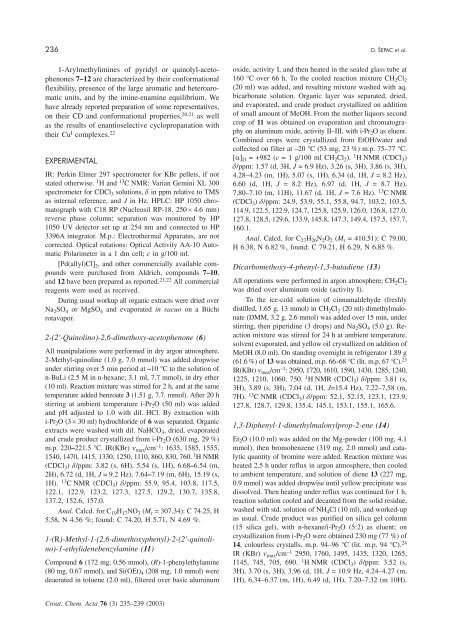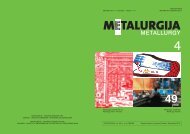Comparative Study of 1,5-Dinitrogen Schiff Bases as Potential ...
Comparative Study of 1,5-Dinitrogen Schiff Bases as Potential ...
Comparative Study of 1,5-Dinitrogen Schiff Bases as Potential ...
Create successful ePaper yourself
Turn your PDF publications into a flip-book with our unique Google optimized e-Paper software.
236 D. [EPAC et al.<br />
1-Arylmethylimines <strong>of</strong> pyridyl or quinolyl-acetophenones<br />
7–12 are characterized by their conformational<br />
flexibility, presence <strong>of</strong> the large aromatic and heteroaromatic<br />
units, and by the imine-enamine equilibrium. We<br />
have already reported preparation <strong>of</strong> some representatives,<br />
on their CD and conformational properties, 20,21 <strong>as</strong> well<br />
<strong>as</strong> the results <strong>of</strong> enantioselective cyclopropanation with<br />
their Cu I complexes. 22<br />
EXPERIMENTAL<br />
IR: Perkin Elmer 297 spectrometer for KBr pellets, if not<br />
stated otherwise. 1 H and 13 C NMR: Varian Gemini XL 300<br />
spectrometer for CDCl 3 solutions, in ppm relative to TMS<br />
<strong>as</strong> internal reference, and J in Hz. HPLC: HP 1050 chromatograph<br />
with C18 RP (Nucleosil RP-18, 250 4.6 mm)<br />
reverse ph<strong>as</strong>e column; separation w<strong>as</strong> monitored by HP<br />
1050 UV detector set up at 254 nm and connected to HP<br />
3396A integrator. M.p.: Electrothermal Apparatus, are not<br />
corrected. Optical rotations: Optical Activity AA-10 Automatic<br />
Polarimeter in a1dmcell; c in g/100 ml.<br />
Pd(allyl)Cl 2 , and other commercially available compounds<br />
were purch<strong>as</strong>ed from Aldrich, compounds 7–10,<br />
and 12 have been prepared <strong>as</strong> reported. 21,22 All commercial<br />
reagents were used <strong>as</strong> received.<br />
During usual workup all organic extracts were dried over<br />
Na 2 SO 4 or MgSO 4 and evaporated in vacuo on a Büchi<br />
rotavapor.<br />
2-(2'-Quinolino)-2,6-dimethoxy-acetophenone (6)<br />
All manipulations were performed in dry argon atmosphere.<br />
2-Methyl-quinoline (1.0 g, 7.0 mmol) w<strong>as</strong> added dropwise<br />
under stirring over 5 min period at –10 °C to the solution <strong>of</strong><br />
n-BuLi (2.5 M in n-hexane; 3.1 ml, 7.7 mmol), in dry ether<br />
(10 ml). Reaction mixture w<strong>as</strong> stirred for 2 h, and at the same<br />
temperature added benzoate 3 (1.51 g, 7.7. mmol). After 20 h<br />
stirring at ambient temperature i-Pr 2 O (50 ml) w<strong>as</strong> added<br />
and pH adjusted to 1.0 with dil. HCl. By extraction with<br />
i-Pr 2 O(3 30 ml) hydrochloride <strong>of</strong> 6 w<strong>as</strong> separated. Organic<br />
extracts were w<strong>as</strong>hed with dil. NaHCO 3 , dried, evaporated<br />
and crude product crystallized from i-Pr 2 O (630 mg, 29 %)<br />
m.p. 220–221.5 °C. IR(KBr) max /cm –1 : 1635, 1585, 1555,<br />
1540, 1470, 1415, 1330, 1250, 1110, 860, 830, 760. 1 H NMR<br />
(CDCl 3 ) /ppm: 3.82 (s, 6H), 5.54 (s, 1H), 6.68–6.54 (m,<br />
2H), 6.72 (d, 1H, J = 9.2 Hz), 7.64–7.19 (m, 6H), 15.19 (s,<br />
1H). 13 C NMR (CDCl 3 ) /ppm: 55.9, 95.4, 103.8, 117.5,<br />
122.1, 122.9, 123.2, 127.3, 127.5, 129.2, 130.7, 135.8,<br />
137.2, 152.6, 157.0.<br />
Anal. Calcd. for C 19 H 17 NO 3 (M r = 307.34): C 74.25, H<br />
5.58, N 4.56 %; found: C 74.20, H 5.71, N 4.69 %.<br />
1-(R)-Methyl-1-(2,6-dimethoxyphenyl)-2-(2'-quinolino)-1-ethylidenebenzylamine<br />
(11)<br />
Compound 6 (172 mg, 0.56 mmol), (R)-1-phenylethylamine<br />
(80 mg, 0.67 mmol), and Si(OEt) 4 (208 mg, 1.0 mmol) were<br />
deaerated in toluene (2.0 ml), filtered over b<strong>as</strong>ic aluminum<br />
oxide, activity I, and then heated in the sealed gl<strong>as</strong>s tube at<br />
160 °C over 66 h. To the cooled reaction mixture CH 2 Cl 2<br />
(20 ml) w<strong>as</strong> added, and resulting mixture w<strong>as</strong>hed with aq.<br />
bicarbonate solution. Organic layer w<strong>as</strong> separated, dried,<br />
and evaporated, and crude product crystallized on addition<br />
<strong>of</strong> small amount <strong>of</strong> MeOH. From the mother liquors second<br />
crop <strong>of</strong> 11 w<strong>as</strong> obtained on evaporation and chromatography<br />
on aluminum oxide, activity II–III, with i-Pr 2 O <strong>as</strong> eluent.<br />
Combined crops were crystallized from EtOH/water and<br />
collected on filter at –20 °C (53 mg, 23 %) m.p. 75–77 °C.<br />
D = +982 (c = 1 g/100 ml CH 2 Cl 2 ). 1 H NMR (CDCl 3 )<br />
/ppm: 1.57 (d, 3H, J = 6.9 Hz), 3.26 (s, 3H), 3.86 (s, 3H),<br />
4.28–4.23 (m, 1H), 5.07 (s, 1H), 6.34 (d, 1H, J = 8.2 Hz),<br />
6.60 (d, 1H, J = 8.2 Hz), 6.97 (d, 1H, J = 8.7 Hz),<br />
7.80–7.10 (m, 11H), 11.67 (d, 1H, J = 7.6 Hz). 13 C NMR<br />
(CDCl 3 ) /ppm: 24.9, 53.9, 55.1, 55.8, 94.7, 103.2, 103.5,<br />
114.9, 122.5, 122.9, 124.7, 125.8, 125.9, 126.0, 126.8, 127.0,<br />
127.8, 128.5, 129.6, 133.9, 145.8, 147.3, 149.4, 157.5, 157.7,<br />
160.1.<br />
Anal. Calcd. for C 27 H 26 N 2 O 2 (M r = 410.51): C 79.00,<br />
H 6.38, N 6.82 %, found: C 79.21, H 6.29, N 6.85 %.<br />
Dicarbomethoxy-4-phenyl-1,3-butadiene (13)<br />
All operations were performed in argon atmosphere; CH 2 Cl 2<br />
w<strong>as</strong> dried over aluminum oxide (activity I).<br />
To the ice-cold solution <strong>of</strong> cinnamaldehyde (freshly<br />
distilled, 1.65 g, 13 mmol) in CH 2 Cl 2 (20 ml) dimethylmalonate<br />
(DMM, 3.2 g, 2.6 mmol) w<strong>as</strong> added over 15 min, under<br />
stirring, then piperidine (3 drops) and Na 2 SO 4 (5.0 g). Reaction<br />
mixture w<strong>as</strong> stirred for 24 h at ambient temperature,<br />
solvent evaporated, and yellow oil crystallized on addition <strong>of</strong><br />
MeOH (8.0 ml). On standing overnight in refrigerator 1.89 g<br />
(61.6 %) <strong>of</strong> 13 w<strong>as</strong> obtained, m.p. 66–68 °C (lit. m.p. 67 °C). 23<br />
IR(KBr) max /cm –1 : 2950, 1720, 1610, 1590, 1430, 1285, 1240,<br />
1225, 1210, 1060, 750. 1 H NMR (CDCl 3 ) /ppm: 3.81 (s,<br />
3H), 3.89 (s, 3H), 7.04 (d, 1H, J=15.4 Hz), 7.22–7,58 (m,<br />
7H). 13 C NMR (CDCl 3 ) /ppm: 52.1, 52.15, 123.1, 123.9,<br />
127.8, 128.7, 129.8, 135.4, 145.1, 153.1, 155.1, 165.6.<br />
1,3-Diphenyl-1-dimethylmalonylprop-2-ene (14)<br />
Et 2 O (10.0 ml) w<strong>as</strong> added on the Mg-powder (100 mg, 4.1<br />
mmol), then bromobenzene (319 mg, 2.0 mmol) and catalytic<br />
quantity <strong>of</strong> bromine were added. Reaction mixture w<strong>as</strong><br />
heated 2.5 h under reflux in argon atmosphere, then cooled<br />
to ambient temperature, and solution <strong>of</strong> diene 13 (227 mg,<br />
0.9 mmol) w<strong>as</strong> added dropwise until yellow precipitate w<strong>as</strong><br />
dissolved. Then heating under reflux w<strong>as</strong> continued for 1 h,<br />
reaction solution cooled and decanted from the solid residue,<br />
w<strong>as</strong>hed with std. solution <strong>of</strong> NH 4 Cl (10 ml), and worked-up<br />
<strong>as</strong> usual. Crude product w<strong>as</strong> purified on silica gel column<br />
(15 silica gel), with n-hexane/i-Pr 2 O (5:2) <strong>as</strong> eluent; on<br />
crystallization from i-Pr 2 O were obtained 230 mg (77 %) <strong>of</strong><br />
14, colourless crystalls, m.p. 94–96 °C (lit. m.p. 94 °C). 24<br />
IR (KBr) max /cm –1 2950, 1760, 1495, 1435, 1320, 1265,<br />
1145, 745, 705, 690. 1 H NMR (CDCl 3 ) /ppm: 3.52 (s,<br />
3H), 3.70 (s, 3H), 3.96 (d, 1H, J = 10.9 Hz, 4.24–4.27 (m,<br />
1H), 6.34–6.37 (m, 1H), 6.49 (d, 1H), 7.20–7.32 (m 10H).<br />
Croat. Chem. Acta 76 (3) 235–239 (2003)
















